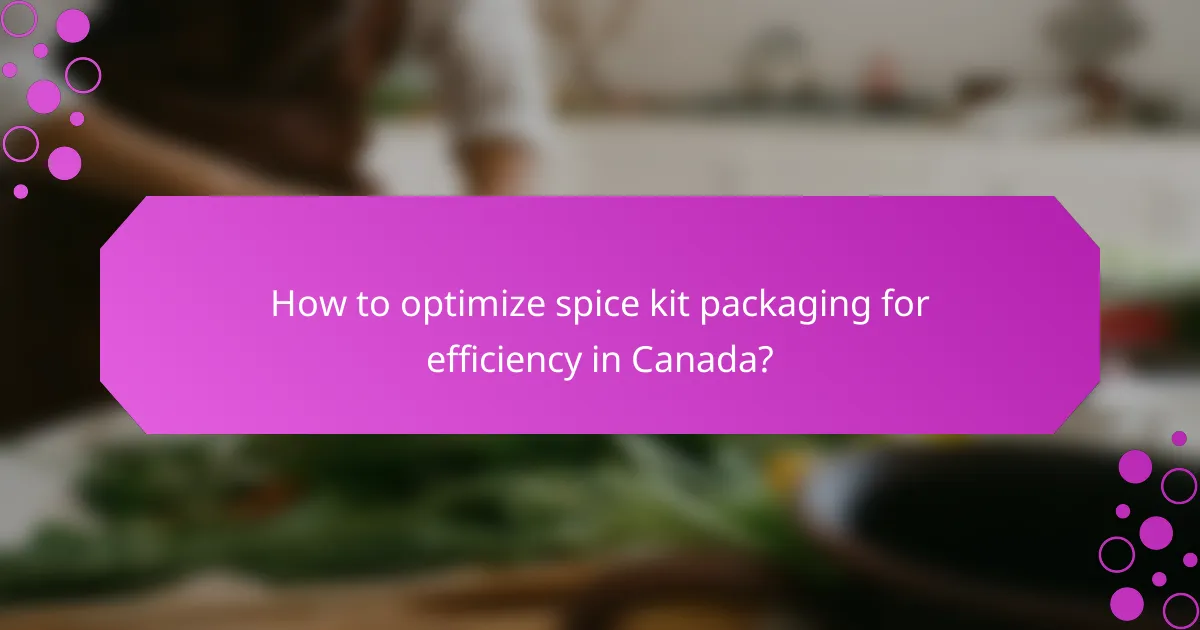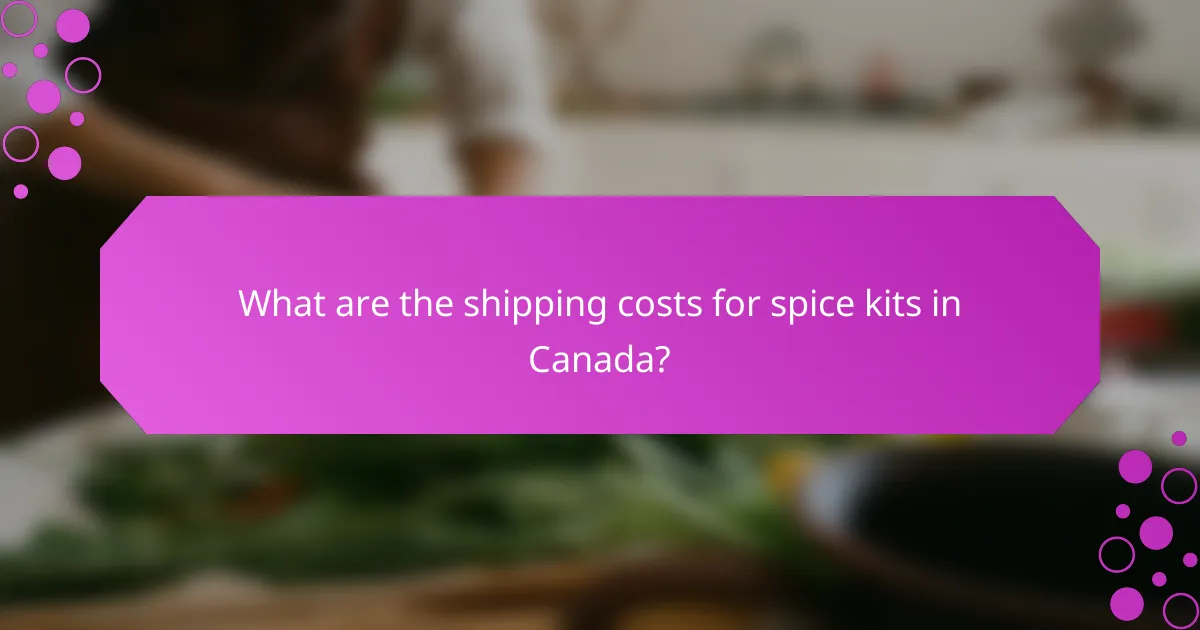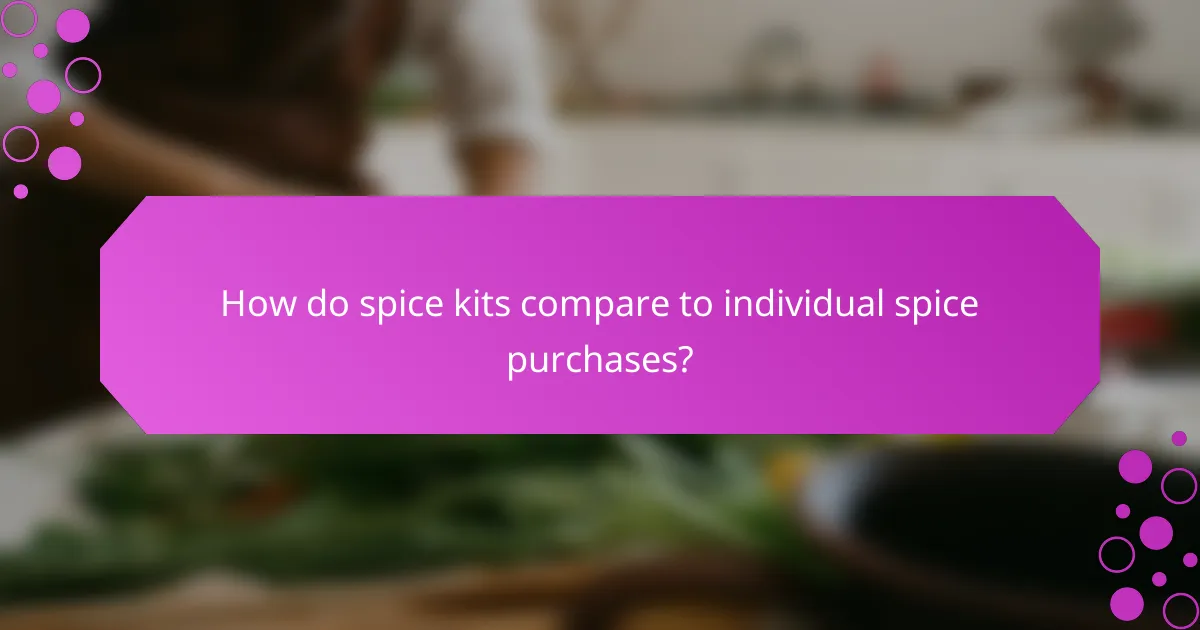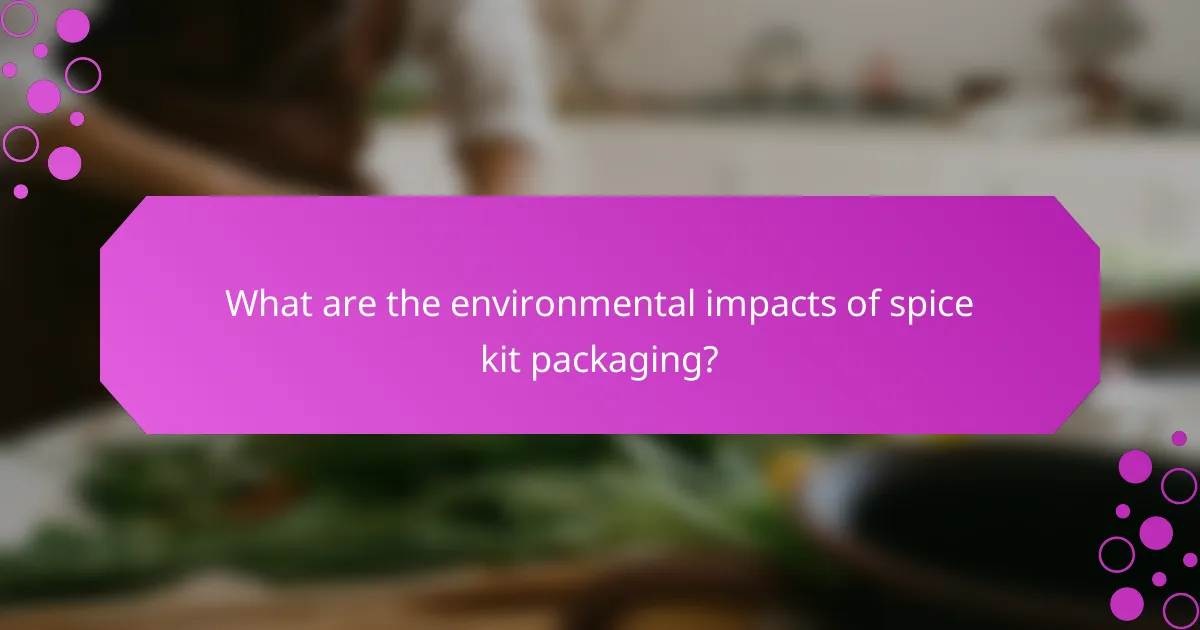Optimizing spice kit packaging is essential for enhancing efficiency, reducing shipping costs, and ensuring ingredient freshness. By focusing on waste reduction and effective moisture control, businesses can maintain the potency and flavor of spices during transit. Understanding shipping variables can also help manage costs, making high-quality spice kits more accessible to consumers.

How to optimize spice kit packaging for efficiency in Canada?
To optimize spice kit packaging for efficiency in Canada, focus on reducing waste, minimizing shipping costs, and maintaining ingredient freshness. Effective packaging solutions can enhance product appeal while ensuring that spices remain potent and flavorful during transit.
Use vacuum-sealed bags
Vacuum-sealed bags are an excellent choice for spice kits as they significantly extend shelf life by removing air that can degrade freshness. This method also reduces the overall volume of packaging, allowing for more efficient shipping and storage.
When selecting vacuum-sealed bags, ensure they are food-grade and suitable for spices. Consider using resealable options to enhance convenience for consumers.
Implement modular box designs
Modular box designs allow for customizable packaging that can accommodate various spice quantities without excess space. This approach not only optimizes shipping costs by maximizing container use but also enhances the unboxing experience for customers.
Design boxes that can be easily stacked and stored, making them practical for both retailers and consumers. Consider using dividers to keep spices organized and prevent cross-contamination.
Choose lightweight materials
Using lightweight materials for packaging can significantly lower shipping costs, especially for international deliveries. Opt for materials like cardboard or biodegradable plastics that provide protection without adding unnecessary weight.
Evaluate the trade-offs between durability and weight. While lightweight options are preferable, ensure they still protect the spices from moisture and light exposure.
Incorporate eco-friendly packaging
Eco-friendly packaging is increasingly important to consumers, particularly in Canada, where sustainability is a priority. Use recyclable or compostable materials to appeal to environmentally conscious buyers.
Consider sourcing materials from local suppliers to reduce carbon footprint and support the Canadian economy. Clearly label packaging to inform customers about its environmental benefits.
Utilize stackable containers
Stackable containers maximize storage efficiency and can simplify shipping logistics. These containers should be designed to fit snugly together, reducing wasted space during transport.
Choose containers that are durable yet lightweight, and ensure they are easy to open and reseal. This functionality will enhance user experience while maintaining the integrity of the spices inside.

What are the shipping costs for spice kits in Canada?
Shipping costs for spice kits in Canada can vary significantly based on factors like carrier choice, package weight, and dimensions. Generally, you can expect to pay anywhere from CAD 10 to CAD 30 for standard shipping, depending on these variables.
Average shipping rates from major carriers
Major carriers in Canada, such as Canada Post, UPS, and FedEx, offer different rates for shipping spice kits. Canada Post typically provides the most economical option for smaller packages, with rates starting around CAD 10 for standard shipping. UPS and FedEx may charge higher rates, often starting at CAD 15, but they offer faster delivery options.
Impact of weight and dimensions on costs
The weight and dimensions of your spice kit significantly influence shipping costs. Heavier packages or those with larger dimensions may incur additional fees, often referred to as dimensional weight pricing. For instance, a spice kit weighing over 1 kg could see shipping costs increase by CAD 5 to CAD 10 compared to lighter options.
To minimize costs, consider using lightweight packaging materials and keeping dimensions as compact as possible. This strategy can help you stay within lower shipping brackets.
Cost-saving strategies for bulk shipping
Shipping spice kits in bulk can lead to substantial savings. Many carriers offer discounted rates for bulk shipments, which can reduce the per-unit shipping cost significantly. For example, shipping ten spice kits together may cost only slightly more than shipping one, depending on the carrier.
Additionally, consider negotiating rates with carriers if you plan to ship regularly. Establishing a business account can often yield lower rates and better service options. Always compare quotes from multiple carriers to find the best deal for your shipping needs.

How to ensure ingredient freshness in spice kits?
To maintain ingredient freshness in spice kits, focus on effective packaging, moisture control, and sourcing from reliable suppliers. These strategies help preserve flavor and potency, ensuring a high-quality product for consumers.
Use airtight packaging solutions
Airtight packaging is crucial for keeping spices fresh by preventing exposure to air, which can lead to oxidation and flavor loss. Consider using vacuum-sealed bags or glass jars with tight-fitting lids to create a barrier against moisture and air.
When selecting packaging, prioritize materials that are durable and resistant to light, as UV rays can degrade spices over time. For example, opaque containers can help shield contents from light exposure, further extending shelf life.
Implement moisture control measures
Moisture is a significant threat to spice freshness, as it can promote mold growth and spoilage. Incorporating desiccants, such as silica gel packets, within packaging can effectively absorb excess moisture and maintain a dry environment for spices.
Additionally, consider using moisture-proof packaging materials that provide a barrier against humidity. This is especially important in regions with high humidity levels, where spices are more susceptible to deterioration.
Source spices from local suppliers
Purchasing spices from local suppliers can enhance freshness by reducing transit time and ensuring quicker delivery. Local sourcing often means spices are harvested closer to their peak flavor, which can significantly improve the quality of the final product.
Establishing relationships with nearby farmers or spice producers can also lead to better transparency regarding the sourcing process and ingredient quality. This approach not only supports local economies but also allows for more sustainable practices in spice production.

What are the best practices for spice kit inventory management?
Effective spice kit inventory management involves using systematic approaches to ensure freshness, minimize waste, and optimize shipping costs. Implementing best practices like FIFO and tracking expiration dates can significantly enhance efficiency and product quality.
Utilize FIFO (First In, First Out) method
The FIFO method prioritizes the use of older stock before newer items, which is crucial for maintaining ingredient freshness. By organizing spice kits so that the oldest items are at the front, you reduce the risk of spoilage and waste.
To implement FIFO, label your spice containers with purchase dates and arrange them accordingly. Regularly check your inventory to ensure that older items are being used first, especially for perishable spices that may lose potency over time.
Track expiration dates effectively
Tracking expiration dates is essential for ensuring that spices remain fresh and flavorful. Create a system to monitor these dates, whether through digital inventory management software or a simple spreadsheet.
Consider color-coding your spice kits based on expiration dates or using a checklist to regularly review your inventory. This proactive approach helps you identify which spices need to be used soon, preventing unnecessary waste and maintaining the quality of your offerings.

How do spice kits compare to individual spice purchases?
Spice kits typically offer a more efficient and cost-effective way to purchase spices compared to buying individual containers. They often include pre-measured amounts of various spices, which can reduce waste and ensure freshness while simplifying the cooking process.
Cost-effectiveness of spice kits
Spice kits can be more economical than purchasing individual spices, especially for those who cook infrequently or want to try new recipes without committing to full-sized containers. A spice kit may cost between $10 to $30, depending on the variety and number of spices included, while individual spices can add up quickly, often exceeding $5 each.
Moreover, buying in bulk can lead to savings, but it also risks having spices lose their potency over time. Spice kits usually contain smaller quantities, ensuring that the spices remain fresh and flavorful for your cooking needs.
Convenience of pre-measured spices
One of the main advantages of spice kits is the convenience of having pre-measured spices ready for use. This eliminates the need for measuring and reduces preparation time, making it easier to follow recipes accurately. For example, a kit designed for a specific dish may include just the right amounts of each spice, streamlining the cooking process.
Additionally, spice kits often introduce users to new flavors and combinations that they might not have considered otherwise. This can encourage experimentation in the kitchen without the hassle of purchasing and storing multiple individual spices.

What are the environmental impacts of spice kit packaging?
The environmental impacts of spice kit packaging primarily involve material recyclability and the carbon footprint associated with shipping. Efficient packaging can minimize waste and reduce greenhouse gas emissions, making it crucial for sustainability in the spice industry.
Recyclability of materials used
Spice kit packaging often includes materials like cardboard, glass, and plastic, each with varying degrees of recyclability. Cardboard is generally recyclable in most regions, while glass can be recycled multiple times without loss of quality. However, plastic packaging may have limited recycling options depending on local facilities and regulations.
To enhance recyclability, brands should consider using mono-materials that are easier to process. Additionally, clear labeling on packaging can guide consumers on proper disposal methods, promoting better recycling practices.
Carbon footprint of shipping
The carbon footprint of shipping spice kits is influenced by packaging weight, shipping distance, and transportation methods. Lighter and more compact packaging can significantly reduce emissions during transit, making it an important factor for eco-conscious consumers.
Companies can optimize shipping efficiency by consolidating orders and choosing carbon-neutral shipping options. Implementing local sourcing strategies can also minimize transportation distances, further lowering the overall carbon impact associated with spice kit distribution.
